 Leading Blog | Posts by Month |
 Leading Blog | Posts by Month |
06.30.19

LeadershipNow 140: June 2019 Compilation
See more on
Posted by Michael McKinney at 02:08 PM
06.26.19

Exploring Your Interior Landscape
THE CHANGING ORGANIZATIONAL and leadership environment is changing at such a pace that leaders need to develop quickly. Coaching, more than training, focuses on an individual’s specific development needs. Technical skills and talents aside, how we lead is a product of who we are. Coaching seeks to make us more aware of the mindset that directs our interactions so that we can become more intentional in our leadership. The same is true, of course, of the coach themselves. While a coach may use certain tools and techniques to help their client, the most critical factor affecting the coaching relationship is the coach. Who you are is how you coach. It is this aspect of coaching that Pamela McLean explores in Self as Coach, Self as Leader. A coach will be far more effective in helping other leaders know themselves if they have a grasp of who they are and what they bring to the coaching relationship. Exploring our own interior landscape is critical as coaches and leaders. McLean states, “The greatest tool we need to cultivate is our self.” What’s more, to know one’s self requires a fierce and courageous willingness to explore the many layers of one’s inner landscape, a territory that can be elusive and enigmatic, confusing and paradoxical. This space can be intimidating if we have not spent much time there. To this end, McLean introduces a process to examine our interior landscape through six broad dimensions of interior knowing that overlap and support one another: presence, empathy, range of feelings, boundaries and systems, embodiment, and courage. “Our most worthy goal as a great coach is to remain at the edge of our growth, always feeling appreciative for where we find ourselves in our development, and simultaneously for where we find ourselves in our development, and simultaneously leaning into new layers and emerging opportunities to deepen our capacity as coach.”
Presence McLean has found that there are three layers or aspects to presence: presence to our inner rumblings (our thoughts, assumptions, biases, and judgments), presence to the relationship (the voice, language, emotion, body and somatic signals of our client), and presence to the ecology or our surroundings. Are we able to put our agenda on the shelf and listen to our clients or fellow workers? We must be able to keep our own experiences out of the equation. Empathy Empathy is a skill that allows us to feel and understand others so that we can “offer sensitive, perceptive, and appropriate communication and support.” But there has to be a balance. Too much or too little can impede our work. She explains how to cultivate the right amount of empathy. And notes: “Take nothing for granted and check your understanding of another’s situation to make sure you aren’t blurring their story with your interpretation or stories.” Range of Feelings It is important for a coach to have an understanding of a wide range of feelings in order to meet others where they are. We begin by taking an inventory of our own feelings. Over time we have developed judgments about certain feelings. “The simple act of uncovering judgements allows us to access some of the off-limits feelings and grow our repertoire.” We are in control of our feelings. “Our reality is that things happen to us and we have a feeling or we decide we have a feeling, but others can never ‘make us feel.’” Boundaries and Systems Coaches need to resist the urge to rescue their client. In coaching, when our boundaries are porous, we have an almost automatic tendency to take on what our clients bring to us, to want to solve, to make others feel better, to save them from themselves, to put on the cape and go to work. When we have appropriate boundaries in place it is easier for us to see the system as a whole—the interconnectedness of everything. Embodiment “Embodiment is all about how we live in our body and allow our body to be the center from which we interact and move in the world.” The way we respond to life and stress is built into our muscle memory and the way we hold ourselves. “The way we sit and stand can change the way we think and feel.” Courage For coaching, courage is about the willingness to face our fears and our long-held ways of thinking and being. Additionally, leaders need courageous coaches. “It takes courage for a leader to seek out a coach and when a leader comes knocking, they deserve the coach’s courage to help them look at that which is invisible or only marginally accessible and uncomfortable to explore.” The Self as Coach Model creates a valuable framework to discover and evaluate how we show up as coaches and leaders. It helps to turn up our awareness of our interior landscape. 
Posted by Michael McKinney at 01:45 PM
06.19.19

Scaling Leadership the McKinsey Way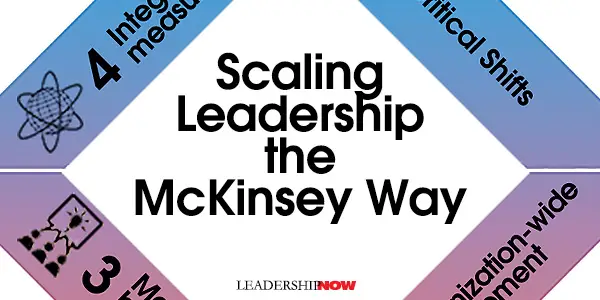
BEFORE YOU BEGIN your next leadership development program, read this. It is not uncommon to hear leaders complain that leadership development programs are not delivering the effective leaders necessary to execute their strategies and purpose. While there is no end of leadership advice, it doesn’t always translate into leaders that can deliver the results the organization needs. In Leadership at Scale, McKinsey partners Claudio Feser, Michael Rennie, and Nicolai Chen Nielson share the McKinsey method for developing more and better leaders across an organization. “Scale implies touching a critical mass of leaders and employees to reach a tipping point—after which point the change become self-sustaining and the organization fundamentally changes how it leads.” To begin, to improve leadership effectiveness in an organization as a whole, it is imperative that leaders “think at an organizational, system-wide level, and the approach one takes to do this differs markedly from that of increasing the effectiveness of individual leaders.” The McKinsey approach is founded on four beliefs that constitute effective leadership: 1. Leaders align, execute and renew. “Leaders make decisions about people and direction (alignment); they see that their intent is carried out (execution); and they think about the next evolution of activity (renewal).” Renewal refers to the constantly changing environment. “Organizational contexts have and will always be changing, and a key element of leadership is thus to display resilience and agility in order to continue to thrive.” 2. All leadership takes place within a context. “We strongly believe that there is no such thing as standard leadership behavior that works irrespective of contextual factors, such as corporate strategy or the level of hierarchy of a given position.” 3. Skills built through real-life experience enable effective leadership behaviors. “Great leaders’ skills are forged on-the-job, and the experience and skills that leaders have accumulated help them display more effective leadership behaviors.” 4. Leaders must develop the right mindsets based on introspection and self-awareness. “We focus on mindsets because mindsets ultimately drive behaviors. Making one’s mindset the subject of conscious scrutiny is an indispensable prerequisite of leadership effectiveness.” That leads us to the Leadership at Scale Diamond. Leadership at Scale Diamond Underpinning the McKinsey approach are four core principles they call the Leadership at Scale Diamond. These principles must exist to increase leadership effectiveness across an organization.
Core Principle 1: Focus on the critical shifts that drive disproportionate value. Link leadership development to the organizational context and strategy and focus on the three to five shifts (behaviors, skill, and mindsets) that will have the biggest impact on performance. Surprisingly, leadership development is often not aligned with the organization’s purpose and strategy. In their research, executives have told them that “their organizations have not translated their strategy to their needs.” Instead, they have used “generic and broad competency models.” The result is not surprising. Their research identified three categories of leadership behaviors: Baseline Behaviors: Effectiveness at facilitating group collaboration, Demonstrating concern for people, Championing desired change, and Offering Critical perspectives. These behaviors apply in any context, but they by themselves do not differentiate between mediocre and top performance.
McKinsey also concluded that only a few behaviors drive organizational performance and that varies by context. So, in addition to context-specific behaviors is the ability of a sufficient number of leaders in an organization to be able to rapidly adjust to different situations and the accompanying behaviors. Core Principle 2: Engage a critical mass of pivotal influencers across the organization to reach a tipping point. Organizations must ensure sufficient breadth, depth, and pace in order to change leadership behaviors across the organization, and to give all employees an understanding of what great leadership looks like. Pivotal influencers are those 5 to 15% that others look to for cues as to what success looks like in the organization. Work first with these people with the understanding that developing a repertoire of leadership capabilities takes time. And of course, the training should reflect that truth. Core Principle 3: Architect programs that maximize behavioral change based on neuroscience. Design interventions with an explicit focus on helping individuals become “better at their daily jobs” using the latest principles linked to neuroscience, to maximize the value and organizational impact of what is taught and learned. Rather than just the teach and classroom approach, leaders need to practice the new behaviors. McKinsey designs programs around seven adult learning principles:
Core Principle 4: Integrate and measure the program in the broader organization Organizations must ensure that the broader ecosystem directly supports and reinforces the shift in behaviors, skills, and mindsets that the leadership development program promotes. You can’t run a leadership development initiative in isolation and expect positive results. The culture of the organization must support it or enable the new behaviors that the organization needs both formally and informally. The authors note that the actual capability building journey is only 25% of what is required. “People’s behaviors are heavily influenced by their broader context, and in order to sustainable shift their behaviors, you need to shift the context.” In part two of the book, they share this approach in practice. It is quite comprehensive, and the case studies are instructive. 
Posted by Michael McKinney at 07:39 AM
06.17.19

Do You Trust Your People?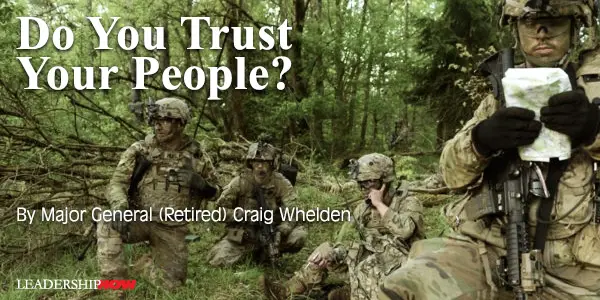
THE GREAT WRITER Ernest Hemingway once said: "The best way to find out if you can trust somebody is to trust them.” I’ve often told people in new organizations I joined that I trust them until that trust is violated. This puts a healthy kind of pressure on them NOT to violate that trust. Stronger performance is often the result. Here are two stories that demonstrate the value of trust: one that reflects what happens when there is no trust, and another that reflects the tremendous performance and learning that comes when there is trust. When No Trust Exists In 1992, I was the G3 (Operations Officer) for one of the Army’s 10 Divisions – forward deployed in Europe. Within a year in the job, I led a military-to-military exchange trip to Hungary, one of the satellite countries of the former Soviet Union. The Cold War had ended, and we were now opening the aperture to Eastern European countries that had been coerced into the Warsaw Pact decades earlier by the strong arm of Russia. After the Berlin Wall fell in 1989, General George Joulwan, the Supreme Allied Commander of all military forces in Europe, established a program called “Partnership for Peace” or PfP. His idea was to reach across the former Iron Curtain so new relationships could be forged between the U.S. and its former foes. The goal was to pull the Warsaw Pact nations out of Russia’s sphere of influence and into ours. My trip was the first such effort the U.S. military did with Hungary, and I was able to witness the difference in approaches to trust between the US military and the Eastern European military—and, by extension, the Russians, since Soviet satellite countries’ military dogma mirrored the mother ship. The Hungarians were truly trying to impress us when they showed us their weaponry, but they were seemingly unaware that the decades-old equipment they had was far inferior to ours if they had to face us in war. The Russians had given frontline nations in Eastern Europe the oldest and least capable equipment, saving the best for themselves. Soviet satellite countries such as Hungary, Czechoslovakia, Poland, and East Germany—rolled into the Soviet arc after World War II—were frankly viewed as cannon-fodder by the Russians. Although I was only a lieutenant colonel at the time, I was treated like a general. Everywhere I turned, only officers (majors and above) were briefing us. They had little trust in their more junior officers and sergeants, like the U.S. places in our junior leaders. Russian influence was everywhere, and the lack of trust and regimentation contrasted sharply with the way the U.S. military operates, where mission orders are issued along with the commander’s intent, thereby giving subordinates the freedom to operate within that framework. In the U.S. military, it’s all about trust and empowerment. I saw little of that in Hungary. A few months later, we reciprocated by bringing senior military leaders from Hungary to our bases in Germany. Most of these delegations consisted of colonels and generals. They were shocked when we turned them over to our sergeants (who actually gave the briefings) and even more shocked when we let them mingle with our troops—out of our earshot—to see what U.S. soldiers were really like. General Joulwan’s approach obviously worked, as a number of former Soviet Union countries are now members of the North Atlantic Treaty Organization (NATO): the Czech Republic, Poland, Bulgaria, Estonia, Latvia, Lithuania, Romania, Slovakia, Slovenia, Albania, Croatia, and Montenegro. And yes, Hungary. When Trust Exists I soon found myself on the list for both colonel and command. My boss called me in one day and told me that I had been selected to command a base. In fact, it was the base we were on: the 98th Area Support Group (ASG), headquartered right there in Wurzburg, Germany. Though I knew little about running a base, it took me just a few months to realize this turn of events was the best thing that ever happened to me. Over 95 percent of my 3,000-person workforce was civilian, half were females, and an equal number were German nationals. I was like a “town mayor” serving more than 45,000 constituents and customers. My leadership style needed to adapt to this very different environment, or I would fail. I was joining THEIR team and needed to learn quickly how to adapt to THEIR environment. Commanding a base required me to put trust, faith, and confidence in a workforce that knew much more about the tasks at hand than I did. I had to lead the team, but at the same time, I had to have confidence that their shared feedback and advice to me was of value. They needed to know that I trusted them. The leadership skills I employed at that time had little to do with the technical aspects of running an Army base, but rather, those that required skills in simply leading people; something I had spent 20 years honing. I found myself praising and encouraging what was working well, and just as importantly, I sought to learn what was not working well and how we could make it better. It wasn’t difficult sorting out the two, as all I had to do was pay attention to those on the receiving end of what we provided. Simply put, I listened to my “customers.” They could be very vocal when something wasn’t right. I understood this well since I too had been a customer of the community for the previous 18 months. This very different experience helped me grow as a leader and prepared me for the rest of my time in uniform and beyond. One of the keys to my success was rooted in the trust I showed my team. It was paid back in exceptional performance. It should be intuitive to most leaders that the higher you climb up the corporate ladder, the greater the reliance you must have on those below you. Support your team and let them do their job, and you’ll be amazed at what they give back. That’s what I tried to do in the 98th ASG, and it worked. It can work for you as well.  
Posted by Michael McKinney at 09:10 AM
06.13.19

Cracking Complexity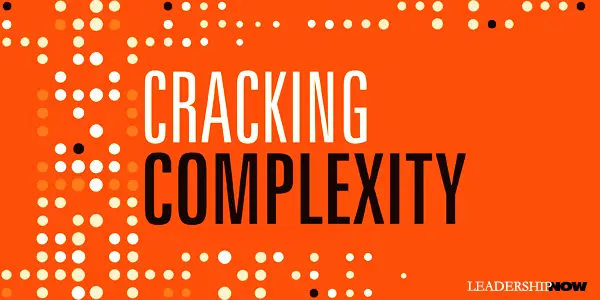
THERE ARE complicated problems, and there are complex problems. Complicated problems are technical in nature. They are linear, orderly, and predictable. Complex problems are adaptive challenges. They are messy, unstable, and unpredictable. “Having a wedding is complicated; having a happy marriage is complex.” If you want to crack a complex problem, you need the code. David Benjamin and David Komlos provide the code in Cracking Complexity. We can master highly sophisticated technical and technological challenges because we’re quite skilled at making linear connections from one technical feat to the next. But complex, multidimensional challenges are categorically different. They are not linear. They are not solved or even solvable through technical prowess. They don’t stand still. They don’t patiently await solutions. Complexity is a whole different ball game. The question is, “How can we best deal with something we’ve never dealt with before, without foreknowledge of what’s going to work?” Conventional approaches to problem-solving typically rely on small groups of smart people cloistered away tasked with deciding the best way forward. We need a new approach to complex problems that allow us to cocreate in large groups. The Complexity Formula A foundational idea behind the formula is Ashby’s Law or the Law of Requisite Variety which states: Only variety destroys variety. “Ashby’s Law says you need to bring a matching amount of variety to the solving process.” In other words, a high-variety group that can collectively address the variety inherent in the issue to be solved. The Complexity Formula helps you to unlock the skills, knowledge, experience, and expertise of the people around you. All the steps in the Formula are complementary and build one upon the next to deliver rapid leaps on complex issues. The first five steps set things up. Steps six through nine are where a requisite-variety of people can spend a short amount of time—typically two days—to sense, absorb, think, decide, and then in Step ten to act on the complex problem. Listed below are the ten steps with some key thoughts on each: 1. Acknowledge the Complexity The first step is to determine exactly what kind of problem you are faced with. A complicated problem or a problem that is truly complex. The first step is “recognizing that there are no known answers, that no outsourced provider is going to figure it out for you—at least fast enough—and that the old way of figuring things out isn’t going to work anymore.” 2. Construct A Really, Really Good Question Frame the issue with a good question. A complex issue needs a question that addresses the complexity. “A good gut check on the question is how people react to it. Are they uncomfortable with it because it challenges the status quo, sets the bar high, or suggests a lot of work needs to be done? Conversely, are they completely comfortable with it because it’s easy to answer? Don’t necessarily retreat from what you think is a good question because people are reacting negatively, and don’t be satisfied if people aren’t pushing back.” Example: “What must we do in the next 12 months to drive necessary changes in mind-set, action, and behavior to fully realize the benefits of…?” 3. Target A Requisite Variety of Solvers Involve the right people. Identify the requisite variety of people needed to match and absorb the complexity. “Your goal is to include the necessary perspectives, characteristics, roles, functions, hierarchical levels, and so on. If you shortchange requisite variety, you’re setting yourself up for no or partial solution and weak execution.” The authors provide a system to be sure you’re getting the right people together. 4. Localize the Solvers Get everyone together face-to-face. It allows for neural synchronization. In Google’s team study, they found what distinguished high-performing teams from low-performing teams is not team cohesion, motivation, or average IQ, but rather frequent turn-taking in conversations and high social sensitivity toward what team members are thinking and feeling. 5. Eliminate the Noise Noise takes all forms: “too much information all at once; too much wrong or inaccurate information; and too much missing, ambiguous, unreliable, or fragmented information.” They recommend that we “Err on the side of too little research, too little data, information, and knowledge—invest the effort instead in the requisite variety of people who carry the tacit data banks and the powerful processors around between their two ears.” 6. Agree on the Right Agenda Do not preset the agenda. Once you get everyone together, begin by deciding what to talk about. “Let the group decide what they have to talk about in order to answer the question. Their first task together is agreeing on how to deconstruct the question into the right component parts to discuss.” 7. Put people On A Collision Course A highly engineered conversation—engineered serendipity. “Serendipity often happens where people, domains, and/or systems collide. And collisions can be engineered. When we talk about domains and systems colliding, we mean people from one domain or system bumping into people from another domain or system.” 8. Advance Iteratively and Emergently You must trust that the answers will emerge. “Your requisite variety group needs to operate with energy and an expectation that the right answers will arise from the right kinds of interactions together.” Also, “Having set their agenda, your group needs to go through that entire agenda once, then again, then again.” Three times is the number—more yields diminishing returns. 9. Change How People Interact Nothing will happen if the interactions between your group members are not productive ones. To be effective, they need to be “candid, incisive, unconstrained, unguarded, transparent, fierce, and focused.” That requires, “discipline and structure, right-sized teams (no more than 8), effective conversation roles, and environment where productive friction is expected and not frowned upon, and have a neutral note taker.” 10. Translate Clarity and Insights into Action “The actions that result from the use of the Complexity Formula fall into three categories: Things to do, things to try, and the newly revealed complexities.” The job in step ten is to categorize the solutions in the three categories and then to attack “each pile in the right way to make progress, to continue learning, and to get after the next big challenge.” Sometimes working on one complexity reveals yet another complexity that needs to be resolved. 
Posted by Michael McKinney at 05:03 PM
06.07.19

How to Tackle Big Challenges in A Networked World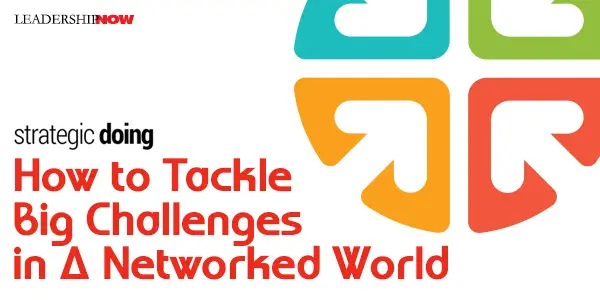
TACKLING THE BIG CHALLENGES when there is no single, simple, rational answer can rarely be done by a single individual or company working alone. Certainly, this is true when facing global, national, or community issues, but it is increasingly true within organizations and small groups. When faced with complex problems, we tend to find a rational answer by analyzing increasing amounts of data and polling for opinions and then announcing the answer to those who must follow. It’s a rigid approach to strategic planning. We need an agile approach that leverages all of the cognitive diversity available to us. In a networked world, the question becomes. “How do you design and guide complex collaborations in open, loosely connected networks when no one can tell anyone else what to do?” Without going into a critique of society, this has become a major concern across a wide range of organizations and institutions. To answer this question, Ed Morrison and his Strategic Doing team* have designed an agile approach to strategic planning that they present in their book, Strategic Doing: Ten Skills for Agile Leadership. Good strategy answers two questions: Where are we going? and How will we get there? The answers to these questions will provide you with an effective strategy, but by themselves, they don’t inspire the engagement that is sorely needed in our time. Strategic Doing divides these two questions into four questions: What Could We Do? and What Should We Do? to provide destination. Then to answer the how we have What Will We Do? and finally, What’s Our 30/30?
These questions encourage networking and real collaboration—“linking, leveraging, and aligning resources in ways that enhance one another’s capacity to create a shared outcome, a mutual benefit.” In telling example, a civic group came together and implemented Strategic Doing concluding, “Strategic Doing broke our grant addiction.” They were able to come together and identify and unlock assets so that the sum was greater than the parts. In a hierarchy, the challenge is to communicate information about what to do down, and to get information about the results up. The Strategic Doing method contains a set of ten skills that work within the framework of the four strategic questions. “Complex collaborations emerge when we follow a small set of simple rules. These rules—really, just the implementation of each of the skills—embed a lot of practices that academics have found valuable in a wide range of academic fields.” The ten skills themselves encourage collaboration as no one person is good at all ten. Transformative results can happen when you enlist a diverse team to bring each of these skills to the network. The Four Questions of Strategic Doing Skills 1 and 2 begin the process by setting the stage for productive, collaborative conversations. Skill 1: Build a safe place for deep and focused conversations. An agile leader will communicate and reinforce equity of voice and the commitment to behave in ways that build trust and mutual respect. Keeping the group size small—5 to 7 people—can also increase our chances of success. Skill 2: Use an appreciative question to frame your conversation. “We live in the world our questions create. We spend time developing framing questions to assure we are all in the same world, as it were—looking a closely as can at the same conversation.” So, we need to define the issue with an asset-based, personally meaningful question that has many answers to encourage people to reflect and think. Question 1: What Could We Do? Skill 3: Identify the assets at your disposal, including the hidden ones. There are assets that team members have control or influence over, but there are also assets that people don’t even know they have. Often these must be coaxed out by others in the group as we all too often, undervalue what we bring to the table. These can include hobbies, skills, and interests that someone has pursued independently over the years. Skill 4: Link and leverage your assets to create new opportunities. Connecting assets allows us to think horizontally. That is, to combine assets from different discipline, fields, or bodies of knowledge. It’s thinking together and extending our minds. Question 2: What Should We Do? Skill 5: Identify a big opportunity where you can generate momentum. Deciding which option has the greatest chance of success is not easy. The authors suggest a 2x2 matrix that considers two criteria to draw out better thinking from the group. Skill 6: Rewrite your opportunity as a strategic outcome with measurable characteristics. At this stage, you are trying to define a shared outcome that everyone can agree on and see in their mind’s eye. It must be emotional, or people will not move on it. It’s not a vague vision statement. The authors suggest asking three qualitative questions to draft an agile strategy: If we are successful, what will we see? What will we feel? and Whose lives will be different and how? Then name ways you might measure the outcome so that you can be sure that everyone understands the outcome in the same way. Question 3: What Will We Do? Skill 7: Define a small starting project to start moving you toward your outcome. You’re not looking for the perfect plan here; you’re looking for action. A small step towards your outcome keeps you from becoming overwhelmed. You don’t need the whole path laid out before you do anything. You just need to begin—and learn as you go. “We really can’t learn how to make progress toward that outcome until we start doing something.” Four qualities of a good start are first, short enough. They engage everyone on the team. The create buzz, garnering attention for the work. They test some key assumptions. And finally, they don’t require permission. Skill 8: Create a short-term action plan in which everyone takes a small step. No spectators. Make sure everyone on the team shares the responsibility for implementation. Question 4: What’s Our 30/30? Skill 9: Meet every 30 days to review progress, adjust, and plan for the next 30 days. Without feedback, we easily get off-track. “Agile leaders need a specific kind of feedback loop: a learning loop.” Change is inevitable, so we need to make adjustments along the way. What are we learning? Does everyone still agree with the outcome we are after? Do we need to make changes? The 30/30 is a guideline 30 days look back and a look forward to the next 30 days. You may need to shorten the timeline to 7/7 or perhaps longer. Skill 10: Nudge, connect, and promote to reinforce your new habits of collaboration. Establishing new habits and making changes are not easy. Agile leaders provide guidance. “If it is vaguely assumed that the network will thrive on its own, it won’t.” Agile leaders nudge everyone to move ideas into action and complete their tasks. They strengthen their network by connecting new people and other networks to it. And they promote it by publishing the successes. These ten skills implemented within the framework of the four questions will create conversations that can lead to transformative change. The four questions are a cycle that you return to again and again to build on what you’re learning by doing and to refine your strategy. *Edward Morrison, Scott Hutcheson, Elizabeth Nilsen, Janyce Fadden, and Nancy Franklin 
Posted by Michael McKinney at 03:56 PM
06.05.19

7 Principles to Lead with Imagination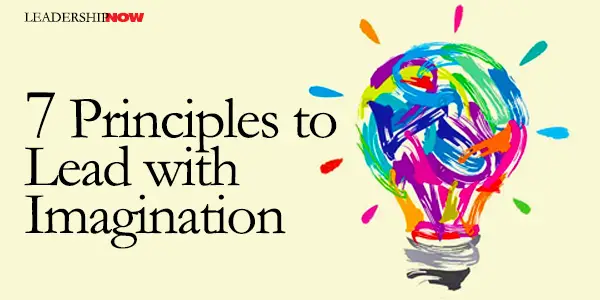
IMAGINATION is about seeing what others don’t see. In a disruptive world, we need leaders with more imagination. We all have the capacity for imagination and applied it has the power to unlock or fullest potential. Brian Paradis was the Chief Financial Officer for Florida Hospital when he was tasked with leading the troubled organization in 2006. Plagued with doubt and inexperience, he records his journey in Lead with Imagination, to turn the enterprise around. Lead with Imagination he writes is about “how to lead and how to do it with imagination. It is first about how to be, about character, before checklists and a list of to-dos.” It’s about “how to release yourself and those you lead from the constraints of the mind’s own making and those of our organizations.” This is a powerful book. Honest, straightforward, and insightful. The lessons Paradis has learned on his journey, we can learn along with him. He cites a passage from General Gordon Sullivan’s book, Hope Is Not a Method, that is particularly instructive. Sullivan was a primary inheritor of a U.S. Army in shambles after Vietnam. Today’s problems can be so close, so intense, that they become like blinders. Getting beyond today begins by imagining your organization out in the future. Ask yourself “What could be?” Postulate the new paradigm, and then imagine your organization in it. Many people seem uncomfortable with this process. They see it as too much art and too little science—as irrelevant theology in a world that has deadlines to meet. It is not. It is how the Army’s leaders of the 1970s and 1980s built the Army that was successful in the Persian Gulf War. It is how successful leaders in business, in all walks of life, in fact, operate: by keeping their eyes on today and on the vision—always moving forward. Imagination is about removing those blinders Sullivan describes. Below, I have reproduced his summary of each of Paradis’ seven principles. You will need to read the stories in each of these chapters to get the full impact of his message. 1. Love in All Interactions Love is the foundation, the soil, and the fuel for imagination. Love is both power and powerful. An act, service, or business endeavor done in love universally turns out better. However, love is hard. It is much easier to give in to fear, cynicism, and self-interest than to lead, live, and serve with love. Paradis says love should be our brand, first inside our organizations so that it can radiate outside our organizations to whomever we serve. 2. Out of the Comfort Zone: Leaning into Authenticity and Humility Once you commit to the principle of love, a high hurdle presents itself when leaning into authenticity in your leadership. At the same time, you must become self-aware about the influence your ego casts. Your ego must be managed. There is not a simple formula for this work. The struggle is the heart of this part of the journey to lead with imagination. It is difficult, if not impossible, to move forward effectively without consistency and balance to your words matching your actions. Authenticity and humility build trust. I end where I began: authentically making mistakes, and in humility, saying sorry, asking for forgiveness, and admitting that sometimes I just don’t know. …This is the place where you will earn the trust of the people you have the privilege to lead as a servant. 3. Chaos, Calm, and A Canvas: Creating the Environment That Matters A leader’s primary job is to set the stage, not perform on it. If you want to lead with imagination, you must unleash the power, capacity, and energy of the many and release the stranglehold of the few—even if the few includes you. This is creative work. We often use the language of ‘creating culture’; however, we don’t think enough about what those words mean. This is work that involves careful thought and consideration of every decision we make as another brushstroke applies the paint, either moving us toward a performance masterpiece of moving us away from it. 4. The Act of Fearlessness: Practicing Vulnerability and Right Risk-Taking Vulnerability is about putting yourself in harm’s potential way, or ‘out there,’ in order to accomplish something. It requires clear and creative action. It exposes you. In that place of exposure, we move from preparing to lead to leading with imagination. First, we take risks personally, then we can begin taking right risks organizationally. This is where the trifecta of imagination, creativity, and innovation get their solid foothold in what might be described as virtuous momentum. 5. Tolerating Curiosity Curiosity starts with questions. Both quality and quantity matter. Asking them is less than half the process. Holding the answer open, suspending judgment, questioning: do we even have the right answer yet? That is the larger half. That is the art. 6. The Misunderstanding About Humor Laughter creates a runway for love to land on, and then take off again. Life is serious, to be sure. Organizations are serious, too, but they are made up of humans. And because of that, humor contributes an essential living element to culture. Humor makes us human. It connects us. It gives us energy and capacity to handle stress and challenge. It lifts us. If we believe people are our greatest organizational capacity, then infusing humor into an enterprise is a high return on investment and undervalued as a creative and cultural force. Humor opens a pathway to breakthroughs and new insights. It becomes a competitive advantage. 7. Connecting the Dots: Doing Whatever It Takes Leadership is hard work. Leading with imagination and leading for results require skill and competence, constant self-evaluation, a servant’s heart, and a relentlessness to get it ‘mostly’ right. It is about asking the important and difficult questions of yourself and of the organization and waiting for the answers. It is about engaging and encouraging what is working and owning and dealing with what is not. It is about finding the way and doing whatever job needs to be done to support the team. It is about continuously and consistently imagining the vision, communicating it, and taking daily action toward it. Benjamin Zander, conductor of the Boston Philharmonic Orchestra, has described the ‘long line’ or vision of musical piece. He explains how the ‘line’ is easily lost with too much attention to single notes or short passages. As leaders, it is our constant job to keep bringing our organizations and enterprises back to the long line of the music and connecting the dots back to the big why. 
Posted by Michael McKinney at 07:55 PM
06.03.19

5 Leadership Lessons: Think Like Amazon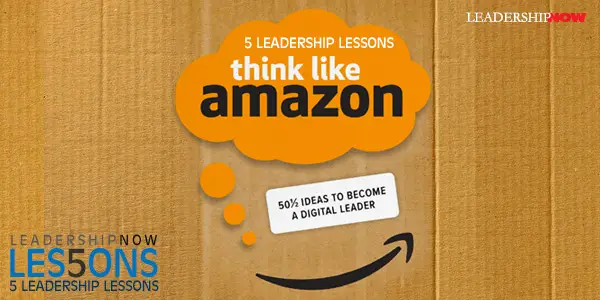
LONG-TERM THINKING is the key to what goes on at Amazon. Jeff Bezos has said, “What we’re really focused on is thinking long-term, putting the customer at the center of our universe and inventing. Those are the three big ideas to think long-term because a lot of invention doesn’t work. If you’re going to invent, it means you’re going to experiment; you have to think long-term. These three ideas, customer-centricity, long-term thinking, and a passion for invention, those go together. That’s how we do it, and by the way, we have a lot of fun doing it that way.” Former Amazon executive, John Rossman provides 50½ ideas that have worked for Amazon and can help you succeed in the digital age in Think Like Amazon. He writes, “Jeff Bezos and Amazon have a remarkably consistent way to approaching and meeting challenges, operating their business and technology, and thinking about new ideas, markets, and growth.” All 50 ideas are a great look behind the scenes. They all may not work for you off-the-shelf, but the principles can be applied anywhere. The 50½ ideas deserve serious consideration, but I‘ll just focus on five here.
And one just for would-be entrepreneurs:
It’s the Internet of Things. At Amazon, it begins with obsessing over their customers. And that means trying many things that often don’t work out and sticking with things that do or might work out. Obsess over better customer experiences to build long-term trust. There are countless opportunities to deliver unique customer experiences by leveraging connected devices. What is the path to make the Internet of Things work for you? Rossman lays out four thoughts: Start with the Customer “Walk yourself through an entire day in the life of your customer. Not just with your product or service, but broadly and deeply. How might connected devices change the way that your product or service fits into that day? Remove Friction Identify and remove friction. “Sometimes, the best way to create a great customer experience is to start by imagining a terrible customer experience.” (Example: Amazon Kindle Fire’s Mayday feature. Service agents can take over a user’s screen remotely to fix problems for them.) Think Broadly Think beyond your immediate area of expertise. For Amazon, the pain point for customers goes beyond just the shopping experience and the products they offer. It extends to the delivery of the product. “Connected devices empower you to learn more about your customers and use these deeper insights to build better products and services for the environments in which they are used. What data would help you understand your customers and their experience better?” Don’t Commit to Scaling Run trials for as long as necessary to get it right before scaling. “One of the biggest mistakes companies can make is to commit to scaling a new feature or capability before it has been thoroughly tested and perfected. Keep new approaches in a beta state and for a limited number for customers. Set their expectations to be realistic, telling them that this is new and a trial.” 
Posted by Michael McKinney at 07:46 PM
06.01.19

First Look: Leadership Books for June 2019Here's a look at some of the best leadership books to be released in June 2019. Don't miss out on other great new and future releases.
Jeffrey Hull shares the secrets, strategies, and science underlying his, and his clients', successes. Interweaving real-life stories with practical tips and the latest evidence-based research, he equips readers with the insights they need to thrive in today's world. Based on his popular classes with Harvard Medical School physicians and NYU business students, Hull has identified the six key elements that leaders in this new workplace need to succeed: Flexibility, Intentionality, Emotional Intelligence, Realness, Collaboration, and Engagement. 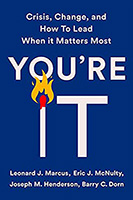 You're It: Crisis, Change, and How to Lead When It Matters Most by Leonard Marcus, Eric McNulty, Joseph M. Henderson and Barry C. Dorn You're It: Crisis, Change, and How to Lead When It Matters Most by Leonard Marcus, Eric McNulty, Joseph M. Henderson and Barry C. Dorn
Today, in an instant, leaders can find themselves face-to-face with crisis. An active shooter. A media controversy. A data breach. You're It takes you to the front lines of some of the toughest decisions facing our nation's leaders-from how to mobilize during a hurricane or in the aftermath of a bombing to halting a raging pandemic. The authors introduce readers to the pragmatic model and methods of Meta-Leadership. They show you how to understand what is happening during a moment of crisis and change, what to do about it, and how to hone these skills to lead high-performing teams. 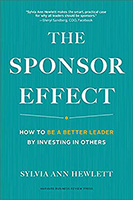 The Sponsor Effect: How to Be a Better Leader by Investing in Others by Sylvia Ann Hewlett The Sponsor Effect: How to Be a Better Leader by Investing in Others by Sylvia Ann Hewlett
Many people know the benefit of finding a sponsor--someone who goes beyond traditional mentorship to partner with a junior-level employee to help build their skills, advocate for them when opportunities arise, and open doors. But few realize that being a sponsor is just as important to career growth as finding one. According to new research, senior executives who sponsor rising talent are 53 percent more likely to be promoted than those who don't. Similarly, middle-level managers who have proteges are 167 percent more likely to be given stretch assignments. But how do you find standout proteges, let alone develop them so that they're able to come through for you and your organization? 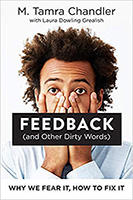 Feedback (and Other Dirty Words): Why We Fear It, How to Fix It by M. Tamra Chandler with Laura Grealish Feedback (and Other Dirty Words): Why We Fear It, How to Fix It by M. Tamra Chandler with Laura Grealish
Feedback: the mere mention of the word can make our blood pressure rise and our defenses go up. However, if we take a step back and think about its true intent, we realize that feedback needn't be a bad thing. After all, understanding how others experience us provides valuable opportunities to learn and grow. When it's done right, feedback has been proven to be the most effective means of improving communication and performance for you and your organization. 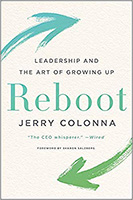 Reboot: Leadership and the Art of Growing Up by Jerry Colonna Reboot: Leadership and the Art of Growing Up by Jerry Colonna
One of the start-up world’s most in-demand executive coaches, Jerry Colonna helps start-up CEOs make peace with their demons, the psychological habits and behavioral patterns that have helped them to succeed—molding them into highly accomplished individuals—yet have been detrimental to their relationships and ultimate well-being. Reboot is a journey of radical self-inquiry, helping you to reset your life by sorting through the emotional baggage that is holding you back professionally, and even more important, in your relationships.
Build your leadership library with these specials on over 39 titles. All titles are at least 40% off the list price and are available only in limited quantities. “The habit of reading is the only enjoyment in which there is no alloy; it lasts when all other pleasures fade.” — Anthony Trollope
Posted by Michael McKinney at 08:22 AM
|
BUILD YOUR KNOWLEDGE


How to Do Your Start-Up Right STRAIGHT TALK FOR START-UPS 
Grow Your Leadership Skills NEW AND UPCOMING LEADERSHIP BOOKS 
Leadership Minute BITE-SIZE CONCEPTS YOU CAN CHEW ON 
Classic Leadership Books BOOKS TO READ BEFORE YOU LEAD |
|